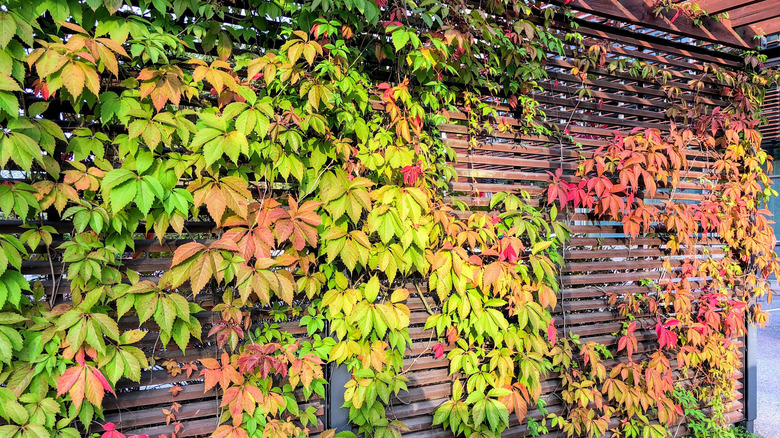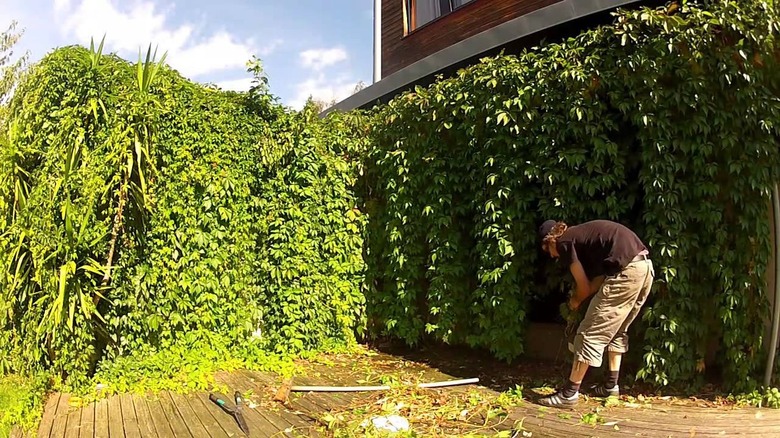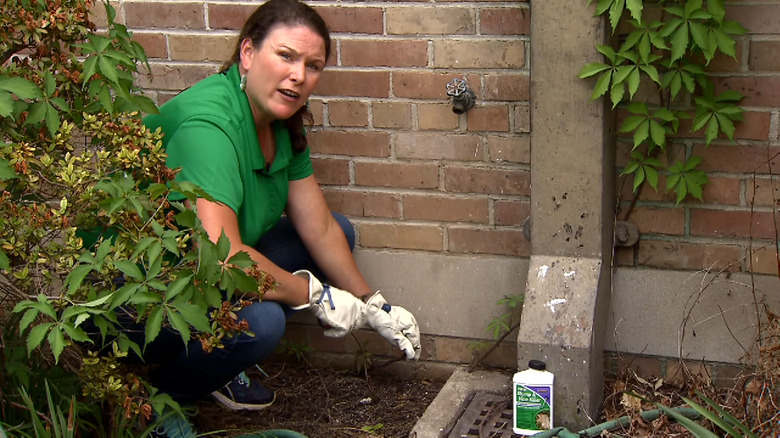Effective Ways To Kill The Virginia Creeper That Is Taking Over Your Yard
It isn't hard to fathom why the Virginia creeper (Parthenocissus quinquefolia) consistently makes it on the list of climbing plants you should grow on your property. It exhibits drop-dead gorgeous burgundy-red foliage during the fall while others prepare for a sleepy winter. Although inconspicuous, its greenish-white flowers and bluish-black berries add wildlife value by feeding songbirds, bees, and small mammals. The woody vines even hold the slope's soil in place through their sucker disks attached to their tendrils.
Unfortunately, this chokehold becomes problematic when these voracious growers begin sending out their offspring (runners) where they shouldn't and smothering desirable vegetation. Once you've realized this isn't what you signed up for, your only natural option is pulling the unruly growth out. But if the bristles have intertwined with your vegetation, moved into hard-to-reach places, or monopolized a major proportion of your yard, you may have to turn to glyphosate. The good news is you can spot-treat the vines to minimize the risk of the adjoining plants suffering accidental herbicide spills.
Dig out or smother the early-germinating woodbine
Brief contact with Virginia creeper can cause some people to develop skin irritation, so wear gloves before you set out to eliminate the vine for good. This will also shield you from poison ivy, a highly toxic plant that loves to get involved with the woodbine. You can learn what poison ivy looks like and how to avoid it: look for three leaves versus five for the native Virginia creeper. Once protected, hold the younglings by the base and pull them out steadily. Ensure you remove all the roots, as even a few remnants can kickstart the cycle afresh. As for the hardier vines, disentangle their shoots from the surrounding vegetation.
Next, depending on the size of the infestation, bring out a trowel or a shovel and dig the invaders out. Remember, Virginia creepers share unmatched resilience skills, so you might have to repeat the process multiple times to nip the problem in the bud. The birds play spoilsport, as they love to munch and drop the self-seeding vine's seeds around the yard, advancing their cause. Don't compost the cut vines, as they may contain viable seeds; send them to the landfill. Another option is to mow the creeped-upon area and cover it with a black plastic sheet if there are no plants you'd like to save. The sun's heat will cook or smother the concerned vines. Don't forget to pick off the black fruits before their seeds germinate.
Chemically treat the established five-leaved creeper
When mechanical removal fails or becomes impractical, resort to a non-selective, post-emergent herbicide, such as glyphosate (such as Roundup Poison Ivy Plus Tough Brush Killer), to eradicate Virginia creeper from your yard. There are two ways to go about this: spot treat or use the cut stump treatment. Spot treatment can be carried out during the summer before the foliage has had the chance to change colors. Decant the herbicide in an empty can, and apply a 1% glyphosate solution to about half of the healthy leafy growth using a sponge wand. Avoid getting it on any of the stressed weeds. Repeat the application until the problem is resolved.
But if you'd rather not deal with the messy foliage, prune the plants to a stump in early fall (late summer works, too).To avoid any mistakes when pruning your plants, ensure the Virginia creeper hasn't completely assumed its fiery red shades yet, as you shouldn't be treating near dormancy. Once done, immediately apply the 1% glyphosate solution to the stump's inner bark tissues. Avoid this method if you can't cut the vines without harming the surrounding growth. Don't forget to don protective gear while handling the herbicide.



